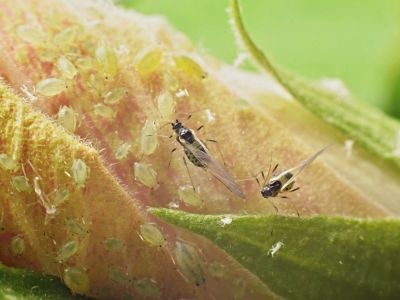Common Pest Problems of Hibiscus
Aphids: Tiny green, white, or black pests that suck the juices from the foliage, usually found in clusters. Control aphids with horticultural oil or insecticidal soap. Whiteflies: Miniscule, gnat-sized pests that suck juices, usually from the undersides of leaves. Control whiteflies with horticultural oil, insecticidal soap, or sticky traps. Thrips: Small, narrow pests that lay eggs inside hibiscus buds, often causing buds to drop before flowering. Control thrips with horticultural oil. Mealybugs: Soft-bodied, juice-sucking pests covered with a protective, waxy, cotton-like mass. Control mealybugs with horticultural oil or insecticidal soap. Scale: May be either armored scales (covered by a flat, plate-like covering) or soft scales (tiny pests with a cottony, waxy surface). Both damage the plant by sucking sap from leaves, stems, and trunks. Control soft scale with horticultural oil or insecticidal soap. Armored scale may require chemical pesticides if cultural controls are ineffective. Ants: Ants don’t directly harm hibiscus, but they eat beneficial insects in order to protect scale, aphids, and other sap-sucking pests that leave sweet excretion on the leaves. (Ants love to eat the sweet stuff, known as honeydew.) Avoid spray, which only kills ants while they’re actively working. Instead, use baits that ants will carry back to the nest. Be patient, as baits tend to take longer than sprays. Root Knot Nematode: While some nematodes are beneficial, root knot nematode can kill plants. The best means of combating it is prevention, usually by solarizing the soil or allowing it to go fallow for a year or two.
Hibiscus Pest Control
Biological Encourage beneficial insects that will help control bugs that feed on hibiscus. Ladybugs are one of the best known, but other helpful insects include syrphid fly larvae, assassin bugs, green lacewings, and parasitic miniature wasps. Use chemical pesticides only when all else fails. Toxic chemicals can decimate beneficial insects, thus making the pest problem much worse in the long run. Often, serious outbreaks of hibiscus plant pests occur after use of chemicals. Insecticidal soap and horticultural oil are much safer, but shouldn’t be used if you notice beneficial insects on the foliage. A systemic root drench may be less harmful than foliar sprays, and may last longer, but it’s a good idea to talk to the folks at your local cooperative extension office before using either. Cultural Keep plants properly watered and fertilized, as healthy plants are less vulnerable to harmful pests. Keep the area around the plant clean and free of plant debris. Remove dead or damaged growth, especially damage caused by pests or disease. Prune hibiscus regularly to provide sunlight and air circulation to the center of the plant.
